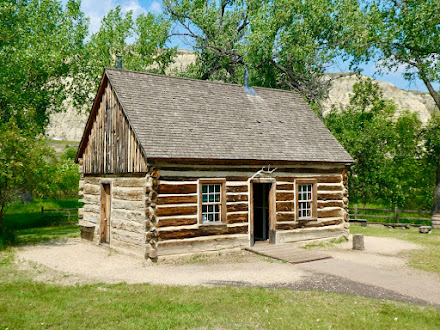After a pretty good breakfast, care of the Miles City Motel, we drove I-94 northeast to Glendive, MT. We navigated through town, crossing the Yellowstone River, to Makoshika State Park, as recommended by Outside magazine. We paid the entry fee and drove into the park – a miniature badlands in silver and greens. The road was paved for about 2 miles then gravel thereafter to the end. of the road At the end, we walked down to view Twin Sisters, a double hoodoo formation among many smaller ones. The area looked like a small version of Bryce Canyon but in paler colors and lusher vegetation.
Twin Sisters
Hoodoos
Next, we drove back partway and stopped for a 1-mile loop hike on the Cap Rock Trail. This trail descended through the various formations to a natural bridge.
Fractured Rock
Coal Seam and possibly the Iridium Band (from the asteroid that collided with the earth and killed off all the dinosaurs).
We drove back into town for dinner supplies at the Albertson store. We left town and the Yellowstone River behind and headed east into North Dakota toward the Little Missouri River. We stopped at the Buffalo Campground, which is in the Little Missouri National Grasslands, to claim our site. We had reserved a site that was more suited for RVs or campers and switched to a smaller and more sheltered site, after talking with the campground host. It was the right thing to do since upon our return to the campground two families with a camper and 2 cars had claimed the site we initially reserved. The campground ‘hosts’ included a family of cottontail rabbits and pale chipmunks, that scurry around.
After setting up camp, we drove about 5 miles east to the small town of Medora, ND which was established in the 1870s as a meat packing town, and later became the entrance to the South Unit of Theodore Roosevelt National Park. We made a quick stop at the visitors’ center, which included a look into the Maltese Cross cabin, the first cabins owned and used by Roosevelt when he tried being a rancher. It included a sitting room, with his rocking chair and bookcase, a small bedroom with his traveling trunk (temporary removed for restoration) and a kitchen, etc. The stove was fired by coal picked up locally from the nearby coal layers exposed by erosion. We could see these layers of carbon bearing rocks throughout the park. They occurred from layers of heavy vegetation followed by inundation by seas and deposition of silts. There was at least one coal vein burning in the park and tourists were instructed “to not report“ the fire.
We drove about 20 miles into the park intending to loop around, but the last section of the road was closed for construction. The terrain was similar to the state park – eroded badlands with distinct layers of gray and tan rocks (and some pink), fringed by bright green vegetation. We saw several active prairie dog towns and one pack of wild horses, but no bison or elk. We drove back out and went a bit farther east to the Painted Canyon Overlook and Visitors Center. There we did a 1-mile nature hike down into the canyon and back up. The walk was fragrant with wildflowers and full of bird songs. I identified a few bird species via their calls using the Merlin app – Spotted Towhee and Indigo Bunting – although we never saw the birds.
Overall, the National Park is less splendid than its more famous cousins, but it commemorates Teddy Roosevelt's commitment to preserving America's natural resources. According to our guidebook he conserved an estimated 230 million acres of land by establishing 51 Federal Bird preserves, 4 National Game preserves, 150 National Forests, 5 National Parks and 18 National Monuments.
We drove back to the campground, had dinner of sweet potato and chicken stir fry. Just after cleaning up, a thunderstorm passed through with lots of rain that last 45 minutes. There was brilliant rainbow just after the precipitation stopped and the sky remained hazy all night long. At 4:30 am, there another rain shower, which helps explains the greenness of the grassland.
Our campground "host."


















Enjoying your commentary and pictures. Unsurprisingly, ND looked a lot like the Badlands of SD that I remember. Katherine would be envious that you are in ND as it’s one of her 2 remaining states to visit. May your adventure continue… EBT
ReplyDeleteThat Makoshika Park does look like smaller, paler version of Bryce! Nice to hear and have some photos about these areas - thanks!
ReplyDelete